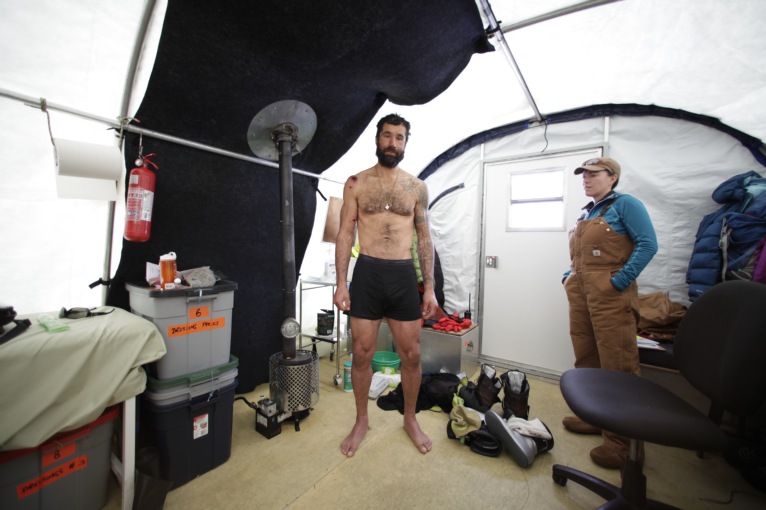Richard answers Antarctica Q&A ahead of final episode
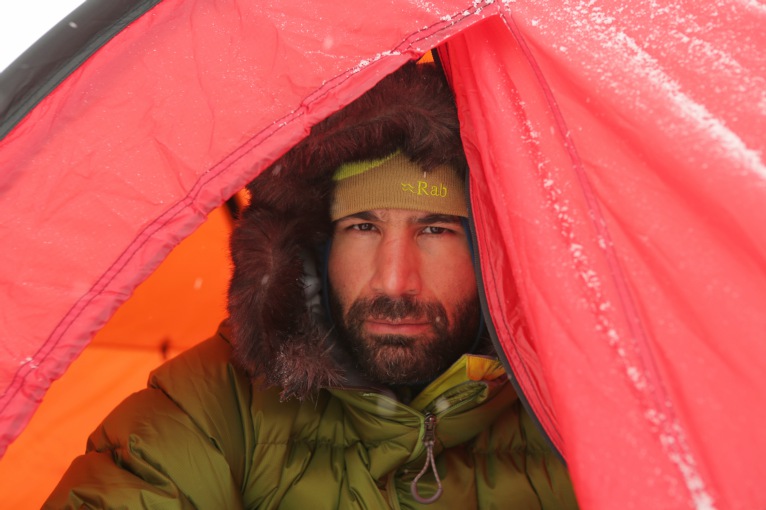
Tonight marks the final episode of Richard’s Channel 5 series Xtreme Endurance: Race to the Pole and the moment he’s been building towards for 18 months. It’s time to head to Antarctica as Richard undertakes his epic 1,150km/750m solo Antarctica speed record expedition, hoping to become the fastest man in history to ski solo, unsupported and unassisted from the geographical coastline of Antarctica to the South Pole.
Viewers will see Richard battle the brutal Antarctic elements of whiteouts, windchill, sub zero temperatures and sastrugi, whilst pulling a pulk that weighs 68.2kg (10st7lb). Richard’s aim is to break Christian Eide’s 24-day speed world record, which was set by the Norwegian in 2011.
Ahead of the show on Channel 5 at 7pm this evening, Richard answers a special Q&A on some of the aspects of his expedition.
Antarctica Q&A
So you are sat on a plane at Heathrow finally ready to fly to Punta Arenas in Chile and then on to Antarctica. After 18 months of preparation it was game time, did you feel ready?
It’s in my nature to always think that I could’ve done more! So I’m not sure that I really felt ready. Physiologically, I was in the shape of my life and I had taken a lot of confidence from the three events I put myself through that year. Technically I was in my arena unlike the previous events. So I was ready, despite still wresting with a lot of last minute emotional white noise.
A final confidence boost before you left was your final testing day at the GSK Human Performance Lab though wasn’t it?
Yes it was. Everyone would have seen the state I was in at the end of the Brutal! All the recovery strategies that Nic (my physio) and I had put in place, including my firefly™ devices, had all come together. After just a few days off I was back ticking over. A week after the Brutal I did my final testing at the GSK Human Performance Lab, where we looked at things like my lactic threshold and VO2 max.
I had gone in feeling a little flat (understandably!) but ironically it was one of the most powerful experiences that I had in those final few stages before Antarctica. I had gone down just a few weeks after the Brownlee brothers had gone in to test. I was using the bike for my VO2 max by now and I got off feeling pretty underwhelmed about what I had done, it didn’t really feel that good to me. However, a lot of the scientists were pretty excited about my test. I couldn’t really understand why, but it turned out that at various stages throughout my test, when all my blood lactate and Co2 readings were suggesting that I was maxing out, I actually had the ability to be able to pull it back three times. The guys were really excited by this.
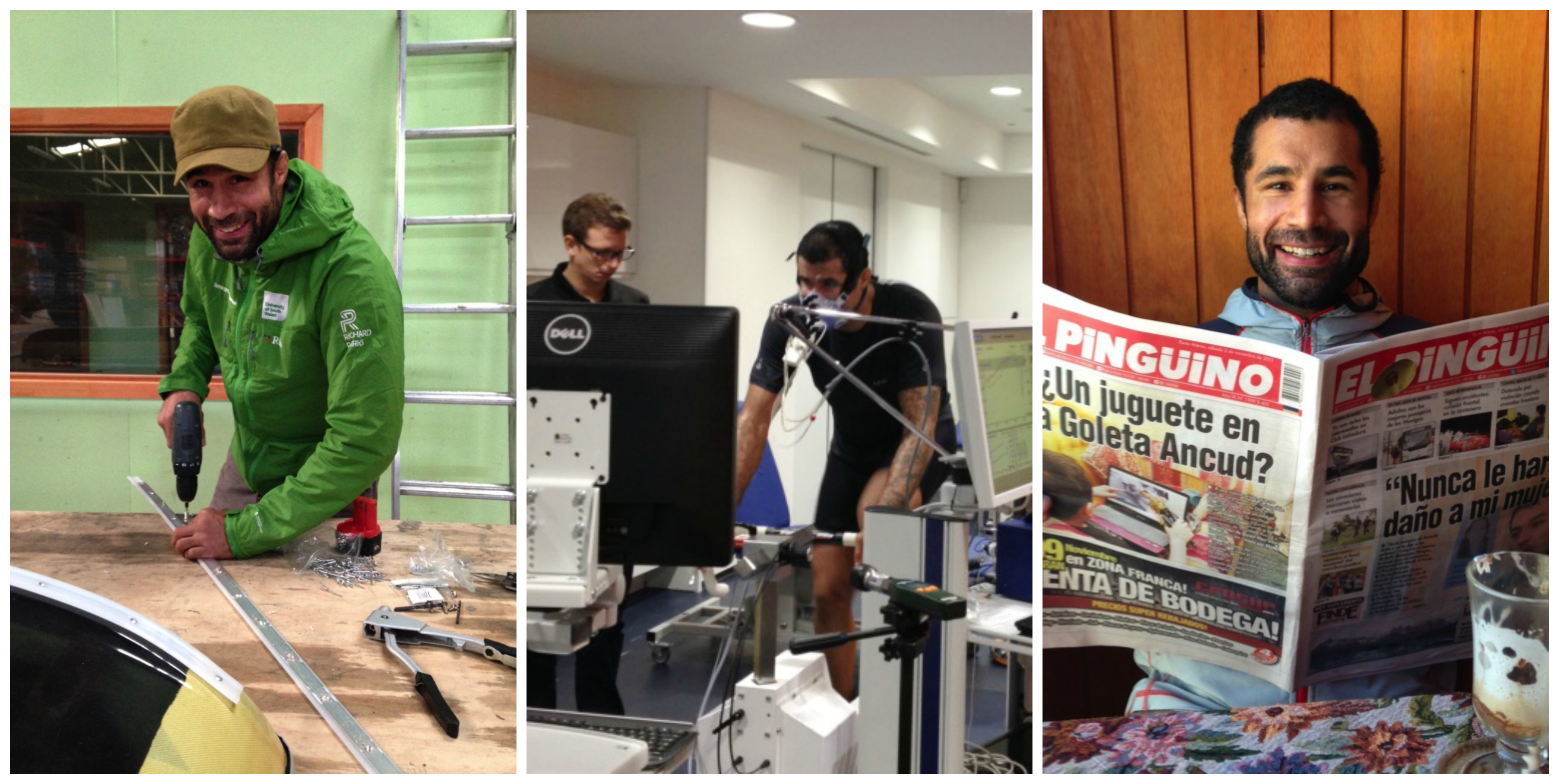 Richard adapting gear in Punta Arenas, testing VO2 max at the GSK Human Performance Lab and waiting for a weather window to fly from Chile to Antarctica.
Richard adapting gear in Punta Arenas, testing VO2 max at the GSK Human Performance Lab and waiting for a weather window to fly from Chile to Antarctica.
Although this was a scientific test to look at pre Antarctica data collection, actually the confidence that this gave me psychologically was huge.
Once you got to Punta Arenas in Chile, did you do anything differently in terms of packing and preparation to your previous R&D expedition in Antarctica?
I didn’t do a lot differently. For all the events I took part in that year, this is the arena that I am comfortable in. There’s always some last minute tweaks and insecurities to battle and wrestle with…it’s the nature of attempting something that very people have ever attempted. The biggest challenge this time was the few weeks in Punta and at Union Glacier Base Camp in Antarctica managing the filming requirements of the expedition.
Although I had spent time at the University of South Wales and with the team from Zig Zag productions who were making my Channel 5 series, and in particular Dale the exec producer and cameraman Rob fine-tuning my camera and camera systems, those few weeks waiting was epic. Every moment available I was questioning and re questioning if I was light enough? Could I be more efficient? Did I need that? I know a lot of the guys down in Punta who are incredibly experienced and experts in this community. More than anyone else they knew the mammoth task I had set myself, not just trying to beat Christian Eide’s 24 day record, which many people considered to be unbreakable, but actually filming myself doing that was a huge ask. Those few weeks there was a lot of self-doubt and questioning. But in a positive way it was actually really valuable as I almost halved the weight of the camera equipment I had to take thanks to spending time with Rob.
This one point sort of slips under the radar when people talk about this solo expedition. In my opinion, the self-filming was one of the most difficult aspects and a really complicated part to manage because time and weight are of the essence. When every minute counts I was already at a deficit having to film on top of actually performing. The art behind covering these kind of distances at these speeds is not just about physical prowess, it’s about discipline, efficiency, and psychological strength. When my existence meant accounting for every single minute of every single day, constantly trying to focus on the process to improve everything every day, every minute taken to set a camera shot up, or do a diary piece to camera, or to change a battery, or anything related to filming put me at a time deficit. I found it hard to get my head around all that.
You had some traditional Antarctic delays before you set foot on the ice, but when you did, how did you feel?
I had spent almost 6 weeks waiting for that elusive weather window to be able to start this expedition. The only analogy I can use, which I talk about in my book Beyond the Horizon is that it was like standing in the tunnel at the Millennium Stadium before the biggest game of my life for 6 weeks! It certainly ramped the pressure up. I did my best to control the controllables and used my time wisely to further fine-tune my systems. There are a lot of experienced people down in Antarctica so it was good to bounce ideas around.
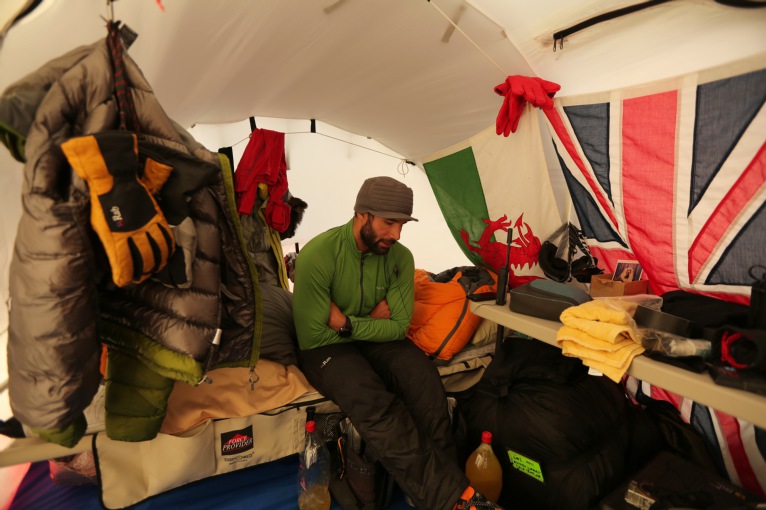
The waiting game at Union Glacier Base Camp
After 3 weeks in Punta, I then had 3 weeks at ALE’s (Antarctic Logistics Expeditions) Union Glacier base camp. Physically, I was out 4 to 5 hours every day skiing, ticking over. We took the opportunity to film some generic stock images to use in the documentary, but the waiting is always an emotional challenge. When I did that get elusive window to start I felt ready. Obviously I felt nervous and apprehensive, that is understandable, but I felt ready. I wanted to get going and I was hungry for it.
As viewers will see this week, the start didn’t exactly go as planned did it?!
No, that particular season in Antarctica wasn’t the most conducive for the speed record. The winter before had a particularly high amount of snowfall and the footing under my skis was soft. It might not seem that much but when the margins for this exped were so fine, the difference between skiing on hard snow and soft snow was absolutely huge. I had reasonable weather conditions, but the footing was just horrific for the first 3 days. The snow only has to be a few inches deep to feel like it’s doubling the weight of your pulk (sled).
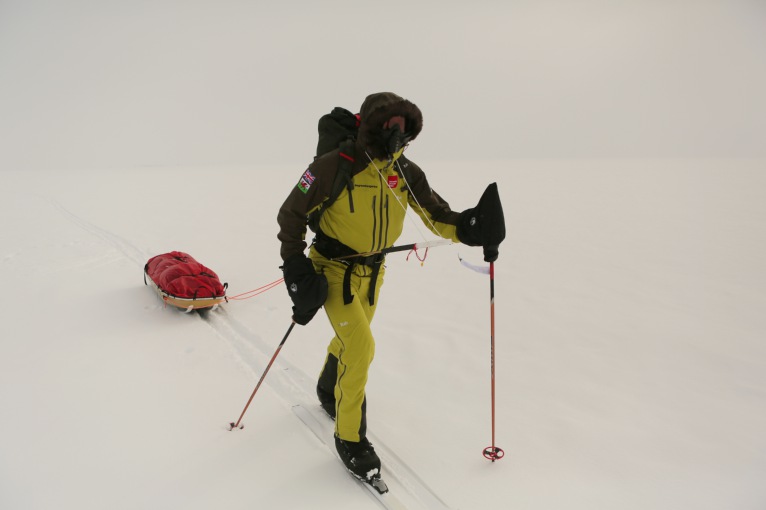
Those first few days were difficult. I knew I wasn’t covering the ground that I had to and I knew I didn’t have the margins to carry these daily deficits. I had to make a very difficult decision to turn around, ski back and start again!
How tough was that decision to make?
There were many emotions swirling around me at that point, some destructive and some constructive. The destructive emotion was to pull the plug and go home - it wasn’t going to happen that year for me. I only had the budget for one airlift, so if it wasn’t from the South Pole when I completed the expedition, it was the end of the project completely. Another initial option was to ski back to Union Glacier Base Camp, which would have been a pretty tough undertaking from my position. However, after talking to Tim Hewitt who was the operational manager for ALE at the time, we talked through a third option. There are so many cogs in this project who go unmentioned but all the guys at ALE were incredibly supportive to me. I consider them my friends now. Tim’s option was to leave a food drop at Hercules Inlet (my start point on the coast of Antarctica) and if I was able to ski back to the start position I could start the expedition again without effecting my food rations, or my record.
After the initial wobble, when I had a bit more clarity of my thoughts, I decided to ski back and start again. Too much and too many people had invested time to this for me to give up, so I didn’t.
As well as filming you had scientific tests to conduct as well, talk us through your typical Antarctica day.
My day started at 5am; get up, re warm some of the melted snow from the night before for breakfast, do a piece to camera, text my blog back home, do a cognitive warm up on a bespoke device designed by the GSK guys and Axon. Then I would go over my route for the day, GPS position, and all the details of the day. I made sure that I had all my food rations for the day accessible in my Rab shell jacket so that I didn’t waste a single minute whilst I was out of the tent. Everything had to be accessible. Then make sure all the cameras were set up and batteries were changed, all memory cards replaced (new memory cards each day to make sure I didn’t miss anything). That would all normally take about an hour and a half. I would load 3 litres of hot water in to two Stanley Flasks, one would just be a hot squash and one would have a specific concoction of electrolytes and carbohydrates that the guys at GSK helped me devise.
I would start skiing before 7am every day, so next would be to empty my bowels into the hole that I had dug to sit in the night before and refill it with snow. Break my tent down, get all my gear in my pulk and start skiing. If I could steal/make up a few minutes every day, this would be a small victory! That was my goal every morning.
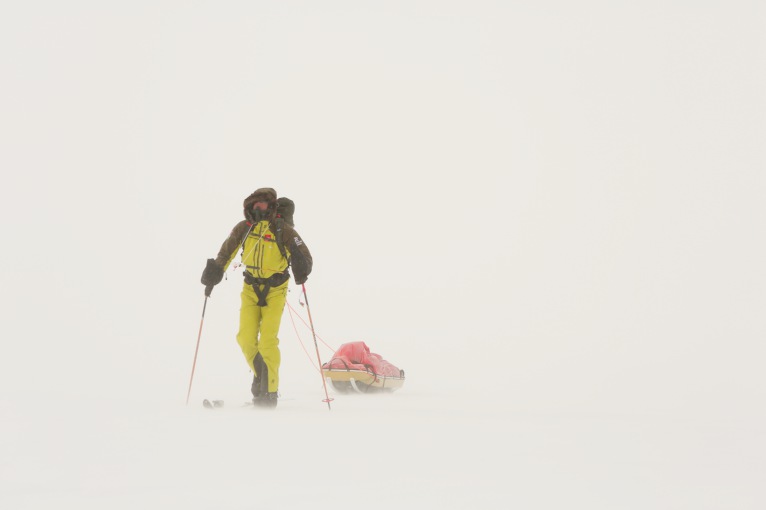
As a result of the work I did in the Brutal I chose to ski in 1 hour 15 min blocks, the optimum physiological and psychological time for me, followed by a 5-minute refuel stop. The vibrate function on my watch alarm would go off at 1 hour 20 min intervals starting at 07:00 - 08:15, 09:35, 10:55, 12.15, 13:35, 14:55. I had a slightly longer break at lunch, instead of 5 minutes I would take 20 mins to eat a hot rice pudding, which was around an extra 1000 calories, then it would go off at 15.15, 16.35, 17.55, 19.15 & 20.35. This routine was operated with military precision. There was no negotiation for me not starting again on the dot. That was my existence. At the end of the day I would find a suitable place to pitch the tent. Working with my partner Rab, my clothing system was incredibly light. I used my physical exertion to manage my body temperature. I would only put on my insulation jackets - a Xenon Hoodie or my Infinity Endurance in extreme situations. I wouldn’t stop until I pitched the tent, often continuing to work hard pitching the tent to avoid having to put my down on. Once I was in it, I would be melting snow for water to rehydrate my Fuizion meals, some days doing recovery protocol with my firefly™ devices, every day filming a piece to camera, some days even filming myself pitch a tent. Then it was refuelling with dinner, maybe a text back home and sleep.
Every seventh day I allowed myself a treat of a note from people I cared about back home. All my admin was done in the morning as it helped me get in the right mind space.
Every evening I would also take saliva samples as well as recording subjective data as to how I was feeling etc for my science partners GSK Human Performance Lab. Every third day I would do a cognitive test – you can find out more about the scientific research I did with GSK on our webcast here.
Finally, your highlight and your lowlight on this expedition?
It’s really hard to pick specific days. People will see a fair amount of suffering again this week on the Telly! But it’s really important to me that I reiterate how much I love what I do. This was an incredibly privileged situation to be in. Very few people have the opportunity to step foot on Antarctica, let alone experience Antarctica in it’s purest and most raw - solo and unsupported. It’s an incredible honour. I know I earned it, but I feel lucky.
Antarctica, like life, can often be both beautiful and cruel. The smallest of things can actually become quite spiritual. On days when conditions are good, it is euphoric and is one of the most incredible places on the planet. On the contrary to that, when the days are bad, it’s savage! Operating solo also adds an emotional microscope on every feeling and thought too. You have to earn it, there are no shortcuts and very little margin for error. That’s the challenge though. I love the purity of it and I feel so grateful to be able to do it.
View Richard's Antarctica picture gallery.
Catch up on episodes of Xtreme Endurance: Race to the Pole on Channel 5 on demand here.
